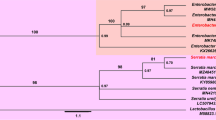Abstract
Laboratory trials were undertaken to investigate the interactions which may occur when rearing the parasitoid,Bracon brevicornis on Sesamia cretica larvae after being injected with the pathogen,Bacillus thuringiensis under 5 constant temperatures.
Bacillus-infected larvae ofS. cretica had detrimental effects on the parasitoid's progeny e. g. prolonged periods of both cocoon stage and total development at 20 or 25 °C; and decreased number of formed cocoons or produced adults at all tested temperatures. The most deleterious temperature for the parasitoid rearing under condition of the bacterial pathogen was 30 or 35 °C.
Zusammenfassung
Laboruntersuchungen an gleichzeitig mitBacillus thuringiensis infizierten und mitBracon brevicornis-Larven besetzten Raupen vonSesamia cretica — bei 5 verschiedenen Temperaturen — ergaben, daß bei den behandelten Raupen die Entwicklungszeit des Parasitoiden bei 20° und 25 °C signifikant verringert war. In allen Temperaturstufen war die Zahl der gebildeten Kokons und geschlüpften Imagines des Parasitoiden bei den infizierten Raupen geringer, also die Sterblichkeit größer. Die für die Zucht des Parasitoiden abträglichsten Temperaturen lagen zwischen 30° und 35 °C, die zuträglichsten Temperaturen zwischen 15° und 20 °C.
With exception of females at 35 °C, no significant differences were recorded among treated and untreated vials for females or males longevity (Table 3).
In order to recognize the most detrimental temperature for the parasitoid rearing under condition of the bacterium pathogenicity, F-test was utilized to analyze the “Untreated — Treated” data. Such analysis revealed that the most detrimental temperature for such parasitoid under condition of the bacterium was 30° or 35 °C.
Similar content being viewed by others
Literaturverzeichnis
Bell, J. V., E. G. King, andR. J. Hamalle, 1974: Interactions between bollworms, a braconid parasite, and the bacteriumSerratia marcescens. Ann. Entomol. Soc. Am.67, 712–714.
Bucher, G. E., 1963: Transmission of bacterial pathogens by the ovipositor of a hymenopterous parasite. J. Insect. Pathol.5, 277–283.
Kaya, H. K., andY. Tanada, 1972: Response ofApanteles militaris to a toxin produced in a granulosis-virus-infected host. J. Invertebr. Pathol.19, 1–7.
King, E. G., J. V. Bell, andD. E. Martin, 1975: Control of the bacteriumSerratia marcescens in an insect host-parasite rearing program. J. Invertebr. Pathol.26, 35–40.
King, E. G., andJ. V. Bell, 1978: Interactions between a braconid,Microplitis croceipes, and a fungusNomuraea rileyi, in laboratory-reared bollworm larvae. J. Invertebr. Pathol.31, 337–340.
Kurstak, E. S., 1966: The role ofDevorgilla canescens (Grav.), in infection byBacillus thuringiensis Berliner, in:Ephestia kuebniella. Zell. Annals Epiphyt17 (3), 335–383 (cf. RAE/56 A, 445, 1968).
Laigo, F. M., andM. Tamashiro, 1967: Interactions between a microsporidian pathogen of the lawn-army worm and the hymenopterous parasiteApanteles marginiventris. J. Invertebr. Pathol.9, 546–554.
Oatman, E. R., 1965: The effect ofBacillus thuringiensis Berliner on some lepidopterous larval pests, apple aphid and predators, and on phytophagous and predaceous mites on young apple trees. J. Econ. Entomol.58, 1144–1147.
Raimo, B., R. C. Reardon, andJ. D. Podgwaite, 1977: Vectoring gypsy moth nuclear polyhedrosis virus byApanteles melanoscelus (Hym: Braconidae). Entomophaga22, 207–215.
Reardon, R. C., andJ. D. Podgwaite, 1976: Disease-parasitoid relationships in natural populations ofLymantria dispar (Lep.: Lymantriidae) in the Northeastern United States. Entomophaga21, 333–341.
Temerak, S. A., 1979: Interactions between the red-pigmented bacterium,Serratia marcescens, the pink borer,Sesamia cretica, and the parasitoid,Bracon brevicornis. Proc. 3rd. Pesticide Conf. Tanta Univ., Egypt Vol. IB p. 519–526.
Temerak, S. A., 1980: Detrimental effects of rearing a braconid parasitoid on the pink borer larvae inoculated by different concentrations of the bacterium,Bacillus thuringiensis Berliner. Z. ang. Ent.89, 315–319.
Wollam, J. D., andW. G. Yendol, 1976: Evaluation ofBacillus thuringiensis and a parasitoid for suppression of the gypsy moth. J. Econ. Entomol.69, 113–118.
Author information
Authors and Affiliations
Additional information
Mit 3 Tabellen
Rights and permissions
About this article
Cite this article
Temerak, S.A. Wirkungen zwischen Bacillus thuringiensis Berl. und Larven der Schlupfwespe Bracon brevicornis Wesm. in bzw. an den Raupen von Sesamia cretica Led. bei verschiedenen Temperaturen. Anz. Schadlingskde., Pflanzenschutz, Umweltschutz 55, 137–140 (1982). https://doi.org/10.1007/BF01902704
Issue Date:
DOI: https://doi.org/10.1007/BF01902704




